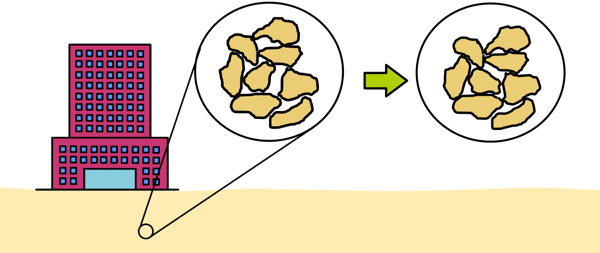In civil engineering, understanding how soils behave under different loading conditions is very important for designing safe and stable structures like foundations, embankments, and retaining walls. Soil mechanics is all about figuring out and predicting how soils respond to stresses and changes in their environment.

One of the important factors to consider when analysing soil behaviour is compressibility, which indicates how a soil’s volume changes under applied loads. Compressibility is particularly important for evaluating soil settlement, as excessive or uneven settlement can lead to significant structural issues.

To quantify and predict the compressibility of soils, engineers rely on a important factor called the Coefficient of Volume Compressibility, denoted by mv. Coefficient of Volume Compressibility is also known as Coefficient of Volume Change.
When soils are loaded, they compress as water is squeezed out and soil particles rearrange, reducing the soil’s volume.

The amount of this volume change depends on the soil’s compressibility, which is closely tied to its composition, structure, and stress history.
The coefficient of volume compressibility tells us how much a soil’s volume changes when the pressure on it changes. This is really important for understanding and predicting how much structures built on soil foundations might settle.
It is defined as the negative fractional change in volume of soil per unit change in effective stress acting on it.

The negative sign is there because when pressure increases, the volume typically decreases.
ΔV is the change in volume of soil
V0 is the soil’s initial volume
Δσ’ is the change in pressure on soil
We can see that if Δσ′ (change in effective stress) is constant, then a higher value of mv will result in a larger volume change in soil. Conversely, a lower value of mv will result in a smaller volume change.
So, it can be said that soils with a higher mv value are more compressible, meaning even a small change in stress can lead to a large change in their volume. And vice versa.
Additionally, clay soils are generally more compressible than sandy soils, so clay soils typically have a higher mv value than sandy soils. This is because clay particles are smaller and have a platy shape, allowing them to rearrange and compress more easily under increased stress. In contrast, sand particles are larger and more granular, leading to less compressibility.

Furthermore, the water content of a soil can also affect its compressibility. Soils with higher water content are generally more compressible. This is because water acts as a lubricant between soil particles, allowing them to rearrange more easily under the applied load.
In coefficient of volume compressibility the term, (ΔV/VO), is called Volumetric Strain. Now let’s re-write it in different form.

Here, the total volume of the soil V0 can be expressed as the sum of the volume of voids (VV) and the volume of solids (VS)

so we re-write it:

If we divide both the numerator and the denominator by VS, we can see that in the numerator, ΔV/VS, represents the change in the void ratio, and in the denominator, VV/VS, represents the initial void ratio of the soil.

re-writing it:

This is also an important relationship to remember.
Further, if we remember, this quantity (-Δe/Δσ’) is the Coefficient of compressibility of soil.

re-write it:

This gives us a relationship between av and mv. Since void ratio is a unitless quantity, the unit of mv is the same as that of av, which is m2/kN.
Like av, the coefficient of volume change mv depends on the effective stress at which it is determined. Its value decreases as the effective stress increases. While av provides similar information about soil compressibility, mv is more commonly used in practice. This is because mv directly relates the change in volume of a soil to the change in effective stress.






